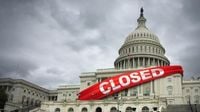As the United States government shutdown entered its second month in early November 2025, its effects rippled across the country, disrupting daily life, straining the economy, and fueling political tensions. With Congress deadlocked and no clear end in sight, Americans faced mounting delays at airports, uncertainty over federal benefits, and growing anxiety about the nation’s economic future.
Air travel became a symbol of the shutdown’s reach. According to reporting by FlightAware, a staggering 4,295 flights were delayed and 557 canceled nationwide by Sunday evening prior to November 3. Passengers at Newark Airport in New Jersey endured waits of up to three hours, with similar scenes playing out at other major hubs in New York, Houston, Dallas-Fort Worth, Chicago, Los Angeles, San Francisco, Denver, and Miami. The Federal Aviation Administration (FAA) acknowledged that 13,000 air traffic controllers and 50,000 TSA officers were working without pay, leading to “stress and fatigue” among staff after more than a month without salaries. “They need support, they need money, they need a paycheck. They don't need to be fired,” Transportation Secretary Sean Duffy told CBS’s Face the Nation, emphasizing that safety remained the top priority, even if it meant slower air traffic.
But the problems went far beyond the airports. In Maryland, where the federal government is the largest employer—providing jobs to approximately 254,000 residents—the shutdown’s effects were especially acute. As citybiz reported, federal contractors in defense, intelligence, and life sciences had to furlough employees or cut work hours. Retailers and hospitality businesses saw sales drop, and the uncertainty around federal contracts caused some companies to delay leasing office space. “Everything has basically come to a halt with awarding and servicing contracts because those federal employees have been furloughed,” said Harry Dematatis, Senior Vice President of NAI KLNB Commercial Real Estate Services. The longer the shutdown drags on, the deeper the financial strain on contractors, with lost revenues piling up and recovery timelines stretching out.
This uncertainty also spilled into the broader commercial real estate market. Owen Rouse, Senior Vice President at MacKenzie Commercial Real Estate Services, pointed out that the interruption of government functions—including the release of key economic data like Census and Bureau of Labor Statistics reports—made dealmaking more complicated and eroded investor confidence. “If you ask 10 people about the economy right now, five will say it’s terrible and five will tell you there are no problems. To me, that is a problem. Why do we not have a clear view?” Rouse remarked, capturing the confusion that has become emblematic of this moment.
Ordinary Americans, meanwhile, voiced growing concern about both the national and personal impact of the shutdown. A CBS News/YouGov poll conducted from October 29 to 31, 2025, found that most Americans felt Congress was not even working to end the impasse. Worry was especially high among lower-income groups, who feared the shutdown’s effect on their own finances. Economic uncertainty—already a persistent theme in recent years—was only exacerbated, with negative views on inflation, the job market, and rising prices dominating the public mood. Few expected prices to decrease in the coming months, and those with the bleakest outlooks were particularly anxious about the shutdown’s economic fallout.
The political fallout was swift and widespread. Approval ratings for Congressional Democrats, Republicans, and President Trump all declined as the shutdown wore on. According to a poll from ABC News, The Washington Post, and Ipsos, 75% of Americans said they were concerned about the shutdown, up from 66% at the outset. President Trump’s approval rating hovered in the low 40s, with particularly poor marks on the economy (37% approval to 62% disapproval) and inflation. Most respondents blamed Trump at least in part for rising prices, and more saw themselves as worse off financially since he took office. Yet the negative perception was not limited to the White House; more Americans viewed the Democratic Party as “out of touch” with ordinary people than said the same about Trump or the Republicans, and the generic congressional ballot remained evenly split.
On Capitol Hill, the standoff showed no signs of abating. Republicans pushed for a “clean” funding bill to reopen the government, while Democrats insisted on tying any measure to an extension of healthcare subsidies set to expire later in the year. President Trump, for his part, urged Senate Republicans to abolish the filibuster—what he called “the nuclear option”—to break the deadlock, a move GOP leaders resisted. “The Republicans have to get tougher. If we end the filibuster, we can do exactly what we want. We’re not gonna lose power,” Trump argued on CBS’s 60 Minutes. House Speaker Mike Johnson countered that eliminating the filibuster could backfire, enabling what he described as “the worst impulses of the far-left Democratic party.” House Minority Leader Hakeem Jeffries, meanwhile, accused Republicans of being “unserious” about reopening the government and criticized Trump’s “my way or the highway” approach.
While the political class argued, the shutdown’s toll on ordinary Americans deepened. In North Bethesda, Maryland, more than 50 volunteers gathered at a food bank to distribute meals to over 500 federal workers impacted by missed paychecks. Some recipients, like Janis—a federal employee from a military family—became emotional describing the uncertainty and financial strain. “The uncertainty of their pay and employment status has taken a toll on their finances and mental health,” CNN reported after speaking with several federal employees waiting in line for food assistance.
Federal benefits and services were also in jeopardy. The shutdown threatened timely distribution of food stamps (SNAP) and healthcare enrollments, with Treasury Secretary Scott Bessent telling CNN that SNAP benefits “could be” restored by a court-ordered deadline, but the process remained unclear. As millions of Americans relied on these programs to make ends meet, the shutdown’s real-world consequences became impossible to ignore.
Looking ahead, the shutdown became a central issue in the final days before key state elections in Virginia, New Jersey, California, and New York. Democrats, including former President Barack Obama and Vice President Kamala Harris, campaigned vigorously, casting the elections as a referendum on the Trump administration. In Virginia, Democratic gubernatorial candidate Abigail Spanberger urged supporters to “set an extraordinary example” and send a message that could ripple through the country. In New Jersey, Rep. Mikie Sherrill criticized her Republican opponent’s embrace of Trump and promised to fight for affordability and lower costs.
As the shutdown set a new record for duration, surpassing the 35-day mark from 2019, its cascading effects—on transportation, the economy, federal workers, and the political landscape—became a defining story of late 2025. With Congress still at an impasse and the White House doubling down, Americans were left waiting, watching, and wondering when relief would finally arrive.


